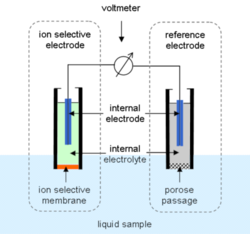Water hardness monitoring with ion-selective sensors
Ion-selective electrodes have a high selectivity for certain ions. They serve as sensors for the concentration or activity of these particular ions in aqueous solution. With the aid of a second electrode (reference electrode), the voltage between the electrodes is measured and which means that the concentration is determined. The voltage depends on the activity of the relevant ion.
The following animation is intended to schematically illustrate the mode of operation of an ion-selective hardness sensor, in particular the activities of the ions on the sensor membrane.
The picture shows a section through a sensor head with metallic electrical discharge (internal electrode) and ion-selective membrane in a sample liquid. The different ions in the sample liquid are represented by different colour dots, for example sodium ions with red, calcium and magnesium ions with blue dots.
Through the sensor membrane diffuse calcium and magnesium ions from the sample liquid to the inner electrolyte in an effort to build an equal ion concentration on both sides of the membrane. The resulting electrical voltage is measured and evaluated to determine the water hardness. Depending on the number of calcium and magnesium ions, a low or high voltage is generated, which is transmitted to the electrical outlet.
Advantages of ion-selective hardness sensors
fast measurements
The measurements take only seconds to a few minutes. Unlike volume expansion methods (swell resin sensors), up-to-date measurement results are available immediately
after the measurement, allowing rapid intervention in the softening process.
simple and ecological measurements
In contrast to titration or other photometric methods, no reagents and complex dosing systems are needed for analysis.
As a result, the process is low maintenance and inexpensive.
continuous measurements
The lifetime of a sensor depends on the water quality, not on the number of measurements.
As a result, continuous measurements are possible, which are particularly advantageous if a complete documentation of the measurement results and / or a fast control should take place.






